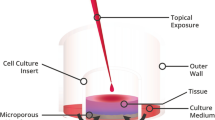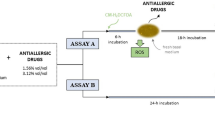Abstract
The corneal stroma is the major barrier to penetration for the lipophilic Cyclosporine A (CsA) molecule and prevents the use of the common ophthalmic solvents. At present, corn oil, castor oil and olive oil are the three most commonly used vehicles. The aim of this study was to determine the effect that topically applied CsA dissolved in different oils has on corneal epithelial permeability measured by fluorophotometry. Forty healthy volunteers, with absence of ocular or systemic disease and not receiving topical or systemic drugs were enrolled. Measurements were taken before and 45 min after the instillation of 40 microliters of a 2% aqueous solution of sodium fluorescein without preservatives. Basal corneal permeability and the permeability 24 h after the instillation of 2% CsA-olive oil, olive oil alone, 2% CsA-castor oil, castor oil alone, 2% CsA-corn oil and corn oil alone, were calculated. To prepare the topical 2% CsA, a Sandimmun oral solution (Sandoz, Basel, Switzerland) was employed under sterile conditions. We found that epithelial permeability 24 h after the instillation of any CsA formulations or solvents increased more than 6.62 times (p < 0.001). No differences in corneal permeability values were found between any of the CsA formulations and the vehicles. We conclude that oils used to dissolve CsA are mainly responsible for the increased corneal epithelial permeability. No differences were found in the effects of the tested solvents on corneal epithelial permeability.
Similar content being viewed by others
References
Belin MW, Bouchard CS, Phillips TM. Update on topical cyclosporin A. Background, immunology and pharmacology. Cornea 1990; 9: 184–195.
Belin MW, Bouchard CS, Frantz S, Chmielinska J. Topical cyclosporin in high-risk corneal transplants. Ophthalmology 1989; 96: 1144–1150.
Mihatsch MJ, Thiel G, Ryffel B. Histopathology of cyclosporine nephrotoxicity. Transplant Proc 1988; 20(suppl 3, no 3): 759–771.
Bach JF. New trends in non-antigen specific immunosupression. Transplant Proc 1979; 11: 851–854.
Palestine AG, Nussenblatt RB, Chan CC. Side effects of systemic cyclosporine in patients not undergoing transplantation. Am J Med 1984; 77: 652–656.
Kana JS, Hoffmann F, Buchen R, Krolic A, Wiederholt M. Rabbit corneal allograft survival following topical administration of cyclosporin A. Invest Ophthalmol Vis Sci 1982; 22: 686–690.
Newton C, Gebhart BM, Kaufman HE. Topically applied cyclosporin in azone prolongs corneal allograft survival. Invest Ophthalmol Vis Sci 1988; 29: 208–215.
Hoffmann F, Wiederholt M. Lokale behandlung des hornhauttransplantates beim menschen mit cyclosporin A. Klin Mbl Augenheilk 1985; 187: 92–96.
Secchi AG, Tognon MS, Leonardi A. Topical use of cyclosporin in the treatment of vernal keratoconjunctivitis. Am J Ophthalmol 1990; 110: 641–645.
Rubin BI, Holland EJ, de Smet MD, Belfort R Jr, Nussenblatt RB. Response of reactivated ligneous conjunctivitis to topical cyclosporine. Am J Ophthalmol 1991; 112: 95–96.
Zierhut M, Thiel HJ, Weidle EG, Waetjen R, Pleyer U. Topical treatment of severe corneal ulcers with cyclosporine A. Graefe's Arch Clin Exp Opthalmol 1989; 227: 30–35.
Nussenblatt RB, Palestine AG. Cyclosporine: Immunology, pharmacology and therapeutic uses. Surv Ophthalmol 1986; 31: 159–169.
Chen YF, Gebhardt BM, Reidy JJ, Kaufman HE. Cyclosporine-containing collagen shields suppress corneal allograft rejection. Am J Ophthalmol 1990; 109: 132–137.
Nussenblatt RB, Dinning WJ, Fuj ikawa LS, Chan CC, Palestine AG. Local cyclosporine therapy for experimental autoimmune uveitis in rats. Arch Ophthalmol 1985; 103: 1559–1562.
Versura P, Cellini M, Zucchini PG, Caramazza R, Laschi R. Ultrastructural and immuno-histochemiacal study on the effect of topical cyclosporine A in the rabbit eye. Cornea 1989; 8: 81–89.
Goichot-Bonnat L, Chemla P, Pouliquen Y. Cyclosporine A collyre dans la prévention du rejet de greffe de cornee a haut risque. J Fr Opthalmol 1987; 10: 213–217.
Göbbels M, Spitznas M. Influence of artificial tears on the corneal epithelium in dry-eye syndrome. Graefe's Arch Clin Exp Ophthalmol 1989; 227: 139–141.
Göbbels M, Spitznas M. Effects of artificial tears on the corneal epithelial permeability in dry eyes. Graefe's Arch Clin Exp Ophthalmol 1991; 229: 345–349.
Göbbels M, Spitznas M. Corneal epithelial permeability of dry eyes before and after treatment with artificial tears. Ophthalmology 1992; 99: 873–878.
De Kruijf EJFM, Boot JP, Laterveer L, Van Best JA, Ramselaar JAM, Oosterhuis JA. A simple method for determination of corneal epithelial permeability in humans. Curr Eye Res 1987; 6: 1327–1334.
Benitez del Castillo JM, del Aguila C, Duran S, Hernández J, Garcia-Sanchez. Influence of topically applied cyclosporine A in olive oil on corneal epithelium permeability. Cornea 1994; 13: 136–140.
Ray WA, O'Day DM. Statistical analysis of multi-eye data in ophthalmic research. Invest Ophthalmol Vis Sci 1985; 26: 1186–1188.
Swan KC, White NG. Corneal permeability I. Factors affecting penetration of drugs into the cornea. Am J Opthalmol 1942; 25: 1043–1058.
Mosteller MW, Gebhardt BM, Hamilton AM, Kaufman HE. Penetration of topical cyclosporine into the rabbit cornea, aqueous humor and serum. Arch Opthalmol 1985; 103; 101–102.
Author information
Authors and Affiliations
Rights and permissions
About this article
Cite this article
Benítez Del Castillo, J.M., Castillo, A., Toledano, N. et al. Influence of topical Cyclosporine A and dissolvent on corneal epithelium permeability of fluorescein. Doc Ophthalmol 91, 49–55 (1995). https://doi.org/10.1007/BF01204623
Accepted:
Issue Date:
DOI: https://doi.org/10.1007/BF01204623




